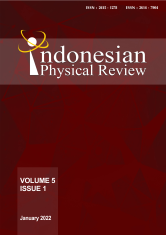THE VALUE OF VISCOSITY COEFFICIENT OF COOKING OIL RESULTED BY PURIFICATION BASED ON ACTIVE CHARCOAL TEMPERATURE WITH THE FALLING BALL METHOD
DOI:
10.29303/ipr.v5i1.140Downloads
Abstract
A change in viscosity indicates the damage to cooking oil. The value of the viscosity coefficient indicates the level of viscosity. This value describes the drag caused by friction between the cooking oil molecules to block the flow. The adhesive property of used cooking oil with a high viscosity value is that it is easy to stick to foodstuffs processed with this oil. Used cooking oil is cooking oil with a high viscosity coefficient value. This oil contains free fatty acids that are harmful to the body. Reuse of used cooking oil for frying foodstuffs is not recommended. Purifying used cooking oil is one way to make cooking oil safe to consume again. The surface adsorption capacity of activated charcoal is increased by heating. Activated charcoal activation temperatures are 27oC, 40oC, 50oC, 70oC, and 90oC.The value of the viscosity coefficient of the purified cooking oil is interesting to study for the activation temperature of the activated charcoal used. The falling ball method was chosen to determine the value of the viscosity coefficient. This method measured the time the ball fell in the oil. Data were analyzed quantitatively descriptively and presented in graphical form. The results show that the value of the viscosity coefficient of the purified cooking oil decreases with the increase in the activated charcoal temperature. The value of the viscosity coefficient of cooking oil as a result of purification using activated charcoal at  90oC is (0.854 ±0.004)  Pa. s
Keywords:
Viscosity oil charcoal temperatureReferences
Taufik M, Seftiono H 2018 Karakteristik Fisik dan Kimia Minyak Goreng Sawit Hasil Proses Penggorengan dengan Metode Deep-Fat Fraying Jurnal Teknologi Universitas Muhammadiyah Jakarta 10(2) 123–130
Deshmukh R K 2019 The Effect of Repeatedly Cooking Oils on Health and Wealth of a Country: a Short Communication Journal Food Proces. Technology 10(8) 1–4
MustafaS O, Kurniawan A, Muslimin N A 2021 Pemurnian Minyak Jelantah dengan Metode Adsorbsi menggunakan Arang Aktif dari Serbuk Gergaji Kayu Ulin (Eusideroxylon Zwageri) Jurnal Riset Teknologi Industri 14(2)124–132
Muhammad H N, Nikmah F, Hidayah N U, HaqiqiA K 2020 Arang Aktif Kayu Leucaena Leucocephala sebagai Adsorben Minyak Goreng Bekas Pakai (Minyak Jelantah) Physics Education Research Journal 2(2)123–130
Mohdaly A AE-R, Seliem K A E-H, Maher A El-M, Mahmoud A A T 2017 Effect of Refining Process on the Quality Characteristics of Soybean and Cotton seed Oils Intenational Jounal of Current Microbiology Applied Sciences 6(1)207–222
Ariani T, GumayO P U 2017 Pengaruh Adsorben terhadap Kualitas Fisik Minyak Science and Physics Education Journal (SPEJ) 1(1) 1–6
AryaniF, Mardiana F, Wartomo2019Aplikasi MetodeAktivasiFisika Dan Aktivasi Kimia Pada PembuatanArangAktifdariTempurungKelapa (Cocos nucifera L) Indonesian Journal of Laboratory 1 (2)16-20.
SNI : 3741-2013 Minyak Goreng Badan Standardisasi Nasional 1-23
Yusibani E, Yufita N Al H E 2017 Viscosity Measurement Of Palm Cooking Oil Products After Heating Jurnal Teknologi dan Industri Pertanian Indonesia 9 (1) 15-23
Giancoli D C 2001 Physics : Principles with Applications (Jakarta : Erlangga)
Shoaliha K, Bahtiar. Arizona K 2020 Analisis Kualitas Minyak Goreng berdasarkan Suhu Pemanasandengan MetodeKoefisienViskositas Falling Ball Indonesian Physical Review 3 (1) 15-23
Esteban B, RibaJ-R, Baquero G, Rius A, Puig R 2012 Temperature dependence of density and viscosity of vegetable oils Biomass and bioenergy 42164-171
Eguchi Y, KarinogT2008 Measurement of Rheologic Property of Blood by a Falling-Ball Blood Viscometer Annals of Biomedical Engineering 36 (4) 545–553
License
Copyright (c) 2022 Authors

This work is licensed under a Creative Commons Attribution-NonCommercial-ShareAlike 4.0 International License.
Authors who publish with Indonesian Physical Review Journal, agree to the following terms:
- Authors retain copyright and grant the journal right of first publication with the work simultaneously licensed under a Creative Commons Attribution-ShareAlike 4.0 International Licence (CC BY SA-4.0). This license allows authors to use all articles, data sets, graphics, and appendices in data mining applications, search engines, web sites, blogs, and other platforms by providing an appropriate reference. The journal allows the author(s) to hold the copyright without restrictions and will retain publishing rights without restrictions.
- Authors are able to enter into separate, additional contractual arrangements for the non-exclusive distribution of the journal's published version of the work (e.g., post it to an institutional repository or publish it in a book), with an acknowledgment of its initial publication in Indonesian Physical Review Journal.
- Authors are permitted and encouraged to post their work online (e.g., in institutional repositories or on their website) prior to and during the submission process, as it can lead to productive exchanges, as well as earlier and greater citation of published work (See The Effect of Open Access).





